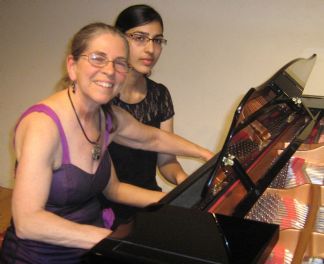|
Other
CHARMING "BARBER" A MENDO FESTIVAL TRIUMPH
by Pamela Hicks Gailey
Friday, July 21, 2023
Other
JOYFULLY WE SING
by Pamela Hicks Gailey
Thursday, February 23, 2023
Other
SUBDUED PIANISM IN RARE FORTEPIANO RECITAL IN THE RAVEN
by Terry McNeill
Sunday, February 12, 2023
Other
DINOVA PIANISM CHARMS SATED AUDIENCE AT J-B MARIN RECITAL
by Terry McNeill
Sunday, November 20, 2022
Other
CLEARY'S NEW ORLEANS BAND IGNITES PARTY FOR THE GREEN AT SSU
by Terry McNeill
Saturday, September 25, 2021
Other
SIX GUITARISTS IN UNIQUE NAPA RECITAL
by Gary Digman
Sunday, July 25, 2021
Other
STUNNING LINCOLN CENTER CONCERT LAUNCHES FIFTH WEILL SEASON
by Philip Beard
Saturday, October 1, 2016
Other
LATE BEETHOVEN EXPLORED AT MMF CONCERT IN PRESTON HALL
by Paula Mulligan
Thursday, July 21, 2016
Other
ANGUISH AND TRIUMPH IN MENDOCINO FESTIVAL'S BIG TENT
by Kayleen Asbo
Sunday, July 10, 2016
Other
ARCANE ARENSKY TRIO HIGHLIGHTS NAVARRO'S SEASON OPENING CONCERT IN SCHROEDER
by Terry McNeill
Sunday, October 4, 2015
|
 |
 Carolyn Tewari and Jasmin Aliakbari in Sebastopol Nov. 19 |
ALIAKBARI AND TEWARI SHINE IN SEBASTOPOL ARTS CENTER RECITAL
by Terry McNeill
Friday, November 19, 2010
Carolyn Tewari must be the most active performing pianist in Sonoma County. In addition to teaching, she has a full schedule playing in retirement homes, churches and concert halls, and has a penchant for music by women composers and partnerships with colleagues.
On November 19 she joined her duo partner of long standing, Jazmin Aliakbari, in a joint recital of eclectic music in the Sebastopol Center for the Performing Arts. The two women switched at the piano from primo to segundo with an enthusiastic audience of 40 watching every solo and four-hand alignment.
Jane Savage’s Duet, Op. 6, opened the program and was immediately forgettable. Glenn Gould referred to such compositions as “dictation music.” Debussy’s First Arabesque and Beethoven’s “Pathétique” Sonata, Op. 13, both performed by Ms. Tewari, were of course works of different merit. The Debussy featured a slow tempo with the stress on tonal color, the arching right-hand runs played with grace, and the legato triplets were stylishly rendered.
The Beethoven C Minor Sonata has been played in parts around the County by Ms. Tewari, and it was good that she finally tackled the entire work in a public hall. There was palpable momentum and drama in the playing, and left-hand tremolo passages had verve. Ms. Tewari was careful in the Adagio to keep one tempo throughout, and the concluding Rondo had perhaps the Sonata’s most concise playing, the long trill telling.
Poulenc’s Sonata for Four Hands closed the first half, Ms. Aliakbari joining in a clangorous change from the controlled pianism of the Beethoven. There was some unstable playing in the initial Prelude and beguiling juxtapositions of ruminative sound in the “Rustique” second movement. The counterpoint was clear in the finale, with lots of rumbling passages in the low bass and echoes of Poulenc’s large Concerto for Two Pianos. The last chord was held to considerable effect, the playing on balance the best in the first half.
Solo performance returned after intermission when Ms. Aliakbari played Bach’s Toccata in E Minor (S. 914), Chopin’s Third Ballade and the “Suite de Danzas Criollas,” Op. 15, of Ginastera. Though the Bach had good differentiation of voices, and the A-Flat Ballade featured clear right-hand scale passages, neither seemed a work that was yet fully the pianist’s own. The footing in each seemed unsure, the phrases hurried when repose was needed, the dense Bach fugal section lacking a concrete shape. The Ginastera work, from 1946 and similar in parts one and five to the earlier “Danzas Argentinas,” had an idiomatic reading from the pianist, the Creole style palpable and the clusters in the Allegro Rustico powerful indeed.
Four pieces from Grieg’s Peer Gynt Suite No. 1, Op. 46, concluded the formal program. The majestic nostalgia of “Morning Mood” and the singing treble line of the “In The Hall of the Mountain King” were salutary. No author of the transcription for piano four hands was listed.
A final charming work for both artists, the iconic “Tea For Two” from the 1925 Broadway show “No, No, Nanette,” was offered as an encore. It was a tuneful end to a pleasurable evening of rich solo and four-hand piano music.
|

